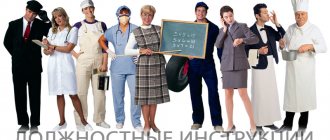Composition of administrative and managerial personnel
In most cases, belonging to the administrative and management personnel (AUP) is determined both by the presence or absence of a production function, and by the necessity of carrying out the activities of an enterprise employee for the normal functioning of the organization.
Administrative and managerial personnel in general include:
- General Director and managers at all levels.
- Deputy managers at all levels. Employees replacing managers perform their direct functions when necessary and therefore are also included in the administrative and managerial staff of the organization.
- Employees heading structural divisions at enterprises.
- Chief accountant and other accounting staff. The chief accountant is the responsible person and is considered the position of the first level of management. Despite the fact that the activities of the accounting department are not directly related to management as a whole, given its absolute necessity for economic activity and the lack of a production component, the chief accountant and all accounting employees are classified as administrative and managerial personnel.
- Finance department employees.
- HR department employees. HR department employees also do not participate in the production of inventory or direct provision of services to clients, for which the business entity will receive a profit. However, the presence of personnel workers is also necessary for the enterprise, which classifies personnel service employees as part of the structure of administrative and managerial personnel.
- Employees of the planning and economic department.
- Lawyers. Lawyers are classified as production personnel only when they provide services to the organization's clients. If lawyers work only for the enterprise itself and in its interests, then they are part of the administrative and managerial staff.
- Other categories of employees. Such employees of the organization include clerks, office workers and other employees who perform administrative activities that ensure the normal functioning of the enterprise.
Who are administrative workers?
To people who are far from issues of management and personnel policy, it seems that only those who directly supervise and manage can be classified as administrative employees.
This is wrong. No organization can exist without those who organize the activities of other employees and are involved in financial, personnel, and legal issues. Definition
Administrative workers include those who ensure the life of the enterprise. They directly make decisions and manage, or are engaged in technical support of the management process.
The classification of administrative workers is quite arbitrary. Indeed, depending on the specifics of the enterprise’s activities, the staffing table may be different, and employees of the same position can perform different functions.
| Your ideal document Download a package of essential documents for the HR department |
Strict distribution of personnel into various categories is important for public sector enterprises, as they are subject to salary distribution standards.
Tasks solved by administrative and managerial personnel
Administrative and managerial personnel are necessary primarily for enterprise management.
At the same time, administrative and managerial personnel exercise control over the performance of functions assigned to other employees and also regulate their activities.
The tasks of administrative and management personnel may be as follows:
- Control. Administrative and managerial personnel must manage everything that happens at the enterprise. Such workers are required to organize all vital processes to ensure uninterrupted production of products or the functioning of the enterprise.
- Control. The task of all managers is to ensure effective supervision of subordinate employees. In addition, administrative staff must also monitor other aspects of the enterprise.
- Labour Organization. Labor organization is the creation of an optimal management structure. The manager selects workers for a specific job, delegating to them tasks or powers, or the right to use the resources of the enterprise;
- Motivation (activation). Motivation (activation) is a set of methods that stimulate employees to work more efficiently;
By solving these problems, administrative and managerial personnel ensure the efficiency of the organization.
Getting groups
It is carried out according to the electrical safety personnel must consist of employees with access group no lower than 3. It is assigned after working in the specialty for more than 3 months. It is issued after familiarization with the design of electrical installations and the procedure for maintenance without the help of others.
Then you need to work for 6 months with this qualification, after which it is possible to increase level to 4. To do this, you need to know the basics of electrical engineering and study various circuits. The exam will include tasks that will test a person’s readiness for work. The assigned qualification allows you to get a job in your specialty. Over time, you need to undergo retraining in order to get the next group.
Costs for maintaining administrative and management personnel
The costs of maintaining administrative and managerial personnel are related to the costs of managing enterprises and organizations.
Administrative and management expenses include:
- salaries of administrative and management personnel of the enterprise;
- deductions from the salaries of the administrative and managerial personnel of the enterprise, subject to payment to extra-budgetary funds;
- depreciation of fixed assets used in the work of the administrative and managerial personnel of the enterprise (computers, printers, scanners, etc.);
- expenses for the accounting program and reference and legal systems (for example, SPS “CONSULTANT”, SPS “GLAVBUKH” or SPS “GARANT”);
- business travel expenses;
- office, postal and telephone expenses;
- expenses for passenger transport;
- costs of maintenance and ongoing repairs of equipment and administrative buildings;
- expenses for advanced training of specialists;
- expenses for maintaining security, etc.
The amount of administrative and management expenses is mainly determined by the number of administrative and management personnel of the enterprise.
The reduction of administrative and management costs is facilitated by measures aimed at simplifying the management structure, reducing the number of administrative and managerial personnel of the enterprise, improving the organization and technical equipment of their work.
Technical staff
The technical staff includes employees with appropriate secondary specialized education. For example, POT RM-016-2001 “Rules on labor protection during the operation of electrical installations” refers to administrative and technical personnel, managers and specialists who organize technical and operational maintenance, repair, installation and commissioning work.
► Five situations when an employee must provide you with information and documents
In practice, there remains some ambiguity in the concept of “technical personnel”. Sometimes this is what auxiliary workers (for example, cleaners) are called.
Definition
The main responsibility of technical personnel is to ensure constant, uninterrupted operation of equipment and equipment, specified operating modes.
Technical personnel are:
- service masters,
- Technicians,
- Metrologists,
- Engineers, etc.
Job responsibilities and areas of interest of engineering and technical workers
The determination of the structural characteristics of the personnel of a production enterprise is carried out taking into account the quantitative ratio of various categories (groups) of workers and its composition. Depending on the functions performed, all employees are divided into two large groups. These are industrial production personnel (three “Ps” - PPP) and non-industrial personnel.
The first group includes workers directly involved in the production activities of the organization. The second group is formed from among workers who are in no way connected with the production process, but, at the same time, are its integral component, since they create normal conditions for the operation of the production plant. We are talking about workers in canteens, housing and communal services, health workers, social and cultural services, etc.
In turn, there is a classification of PPPs according to the nature of the assigned functions. We will tell you more about which categories actually fill this list, and how they are divided within each category, below. You will also find out who technical engineers and administrative personnel are, and what the difference is between them.
Support staff
The general concept of support personnel unites those industry-wide positions that are not related to the enterprise management function. However, these employees are also necessary in every organization.
What all employees classified as support personnel have in common is that they provide service to the enterprise as a whole, without participating in the main processes of economic activity. In other words, it is a service that helps the functioning of production. For example, a carpenter in a workshop will process scaffolding for work at height and thereby make it possible to carry out this work.
► How to cancel a dismissal if an employee changes his mind
Order of the Ministry of Communications of April 12, 2020 N 68 regulates the list of 28 support staff positions for educational organizations subordinate to the Federal Communications Agency.
This is for example:
- Operator of copying and duplicating machines;
- Security guard;
- A carpenter;
- Cook;
- Helper worker;
- Worker for complex maintenance and repair of buildings, etc.
When creating a list of positions in a non-state sector organization, it is important to focus not only on the classification of positions in federal institutions of the same industry. It is important to take into account the job responsibilities of the staff and the specifics of the activities of a particular enterprise.
What categories does the general group of PPP include?
Industrial production personnel includes the following categories:
- Workers. They are divided into main and auxiliary. The labor activity of the first of them is connected with the production of the enterprise's products, the second - with the maintenance of production;
- Engineering and technical workers or technical workers, i.e. specialists on whose shoulders lies the responsibility for preparing and managing the production process;
- AUP or administrative and management personnel, whose specialists are directly involved in managing the enterprise, collecting and processing management information, as well as preparing and implementing management decisions;
- MOL or junior service personnel, which includes workers performing service functions (cleaners, cloakroom attendants, storekeepers, etc.);
- Security. This includes specialists who ensure the security of the enterprise. Their activities are aimed at preserving material assets from cases of theft and natural disasters, ensuring the inviolability of information constituting a commercial secret of the enterprise.
AUP: revealing the concept
To date, current legislation does not provide for a single concept that could fully correspond to the abbreviation AUP (administrative and managerial personnel). But there are several mentions in separate regulatory documents.
So, AUP is:
- the category of specialists and managers whose activities are directly related to the implementation of general management (such as structural divisions), accounting, office work and personnel support (9th Order of the Federal Archive of January 14, 2004);
- specialists performing administrative, managerial and organizational functions, which cannot be dispensed with in ensuring the activities of the entire enterprise (Order 3453 of the Ministry of Culture of December 30, 2020);
- persons holding management positions, employees of services (marketing, economic, financial, etc.).
Based on the above characteristics, it is possible to form a general idea of the category of such employees: AUPs are formed by employees who perform responsibilities for the general management of the organization, as well as those whose responsibilities include administrative functions.
Each organization has the right to independently establish a specific list of employees and structural units that can be safely classified as AUP or engineering personnel.
Who is included in the AUP staff?
It is necessary to clearly define, when forming administrative and managerial personnel, who belongs to this group of employees, and for this it is necessary to build on the labor operations that they will carry out. And when the list is compiled, you can begin to form a group, and for this, create a staffing table regarding AUP.
The staffing table is a specific list of positions that are available at the enterprise, and they are established by the employer independently, taking into account the rules of doing business. As a rule, the following positions are included in the staffing table:
- manager or general director;
- heads of departments and deputy general directors;
- heads of departments and services;
- ordinary employees.
Depending on what exactly the organization does, the job titles may be different, but the functional responsibilities are usually identical. For example, in a school there is a director and a head teacher, in a medical institution there is a chief physician, in a large corporation there is a president, in a non-profit organization there is a chairman, but they all perform the same function - they manage a business entity or a government agency.
Depending on how extensive the administrative and management responsibilities of the staff are, their percentage of the total number of company employees may vary. Basically, the optimal composition is considered to be that 15% of 100% employees are administrative and managerial personnel, but, naturally, this figure can vary both up and down.
Administrative and economic personnel - what is it?
When considering the question of what constitutes administrative and economic personnel, it is necessary to understand that the direct legislative regulation of this issue in the Russian Federation is provided rather poorly. Most of the actions to determine the organization’s personnel structure rest with the employer himself, which means that it is he who decides how to divide personnel into various categories. At the same time, there are two radically different approaches to defining the concept of administrative and economic personnel, which are revealed as follows:
- In a broad sense, administrative and economic personnel is one of the highest categories of the personnel structure, including both administrative and managerial and service personnel associated with the conduct of internal business activities. Moreover, in many ways this concept often turns out to be identical to administrative personnel as a whole.
- In a narrow sense, administrative and economic personnel include employees who do not belong to the administrative and managerial personnel, but participate primarily in the internal economic activities of the enterprise. It is from this point of view that this concept will be considered further.
In some situations, issues of classifying employees into the personnel category under consideration may be regulated by separate regulations. Mostly these requirements apply to individual budgetary institutions and can be established not only by departmental documents of federal significance, but also regulated at the municipal or regional level. In particular, a separate definition of administrative and economic personnel is present in educational institutions in Moscow, as well as in the regulations regulating the activities of leper colonies.
The employer, in turn, has the right to independently form a personnel structure and distribute employees among different personnel groups. This approach can be justified for the most efficient organization of work and the use of convenient tools for monitoring and motivating employees. In addition, the distribution of employees into different types of personnel can also help in creating a system of subordination in the enterprise. He can use local regulations and other internal documentation to resolve these issues.
Government agencies
The administrative department of a state institution may include the following departments of independent activity:
- Documentation support.
- Protocol and organizational.
- Control department.
- Economic support.
- Civil service and so on.
It is important to note that in large commercial structures the work takes place differently. The administrative staff in this case represents the business department. It includes office managers, secretaries, service personnel (drivers, cleaners, couriers). The head of the relevant category is fully responsible for the work of the department.
What is the administrative and economic department and what positions are provided in it?
In addition to administrative and economic personnel, many enterprises may also have a separate administrative and economic department. This structure is essentially a unit that resolves internal economic issues, which include:
- Carrying out an inventory of the enterprise.
- Providing the enterprise with the necessary equipment and consumables that are not involved in production activities.
- Control over the condition of property on the organization’s balance sheet.
- Search for suppliers of household goods and consumables.
- Optimization of the work of administrative and economic personnel and their management.
It is necessary to understand that the administrative and economic department does not necessarily include all employees classified as administrative and economic personnel without exception. And vice versa - the heads of this department may well be classified as managerial rather than business personnel.
The positions of the administrative and economic department are also formed according to the general principle of subordination at the enterprise and in accordance with the established internal rules and staffing schedule of the organization. Considering that if an organization has a designated department as a structural unit, it must have a manager. Other positions can be distributed in a way that is convenient for the employer.
Features of recertification
Advanced training is achieved after independently carrying out work and exercising control over other employees when working with devices. After passing the certification, a certificate with the appropriate category is provided.
Control over work with electrical appliances
Based on the principles and norms of international law, the ATP must perform work under decent working conditions. Personnel have the right to social insurance, timely payment for their work, training, and rest. They are entitled to compensation for losses incurred, including compensation for moral damage.
https://youtu.be/7jE4EPmHbOc
Features of regulation of the activities of administrative and economic personnel
There are certain features and nuances in the activities of administrative and economic personnel that the employer should take into account. In particular, it would be useful to pay attention to:
Activity control. It is the administrative and economic character that is most often the source of unreasonable and uncontrollable costs for the organization. Therefore, it is necessary to regularly monitor both the overall efficiency of the activities of this personnel and the targeted use of allocated funds.- Mechanisms of motivation. Effective motivation mechanisms for administrative and business personnel can be introduced based on monitoring their activities. A good method of motivation can be a significant bonus based on the results of the reporting period, including many times the base salary.
- Work schedule. Employers should be careful about the work schedule of administrative and business personnel. Thus, it will be advisable for some employees to offer a flexible schedule, while other employees should always be at their workplaces, depending on their position. It is not necessary to dictate the same standards in this matter to all employees of the category under consideration.
In some cases, there is no point in keeping administrative and economic personnel on the staff of the enterprise. For example, for many organizations it may be relevant to use an outsourcing mechanism or simply attract specialized companies to solve certain internal business issues.
AUP: decoding
The current legislation does not disclose the concept of AUP, which is uniform for all organizations. However, definitions of AUP can be found in individual industry regulations. Thus, administrative and managerial personnel are:
- category of managers and specialists who carry out general management, management of structural divisions, accounting, personnel and office support (Rosarkhiv Order No. 9 dated January 14, 2004);
- employees involved in managing (organizing) the provision of services (performing work), as well as performing administrative functions necessary to ensure activities (Order of the Ministry of Culture dated December 30, 2015 No. 3453);
- managers, employees of financial, economic, marketing and other services (Letter of the Federal Tax Service of the Russian Federation dated June 25, 2009 No. ШС-22-3/ [email protected] );
The given definitions of AUP allow us to identify the general characteristics of such workers. Thus, AUP can include employees who exercise general management of the organization and its structural divisions, and also perform administrative functions. The organization can independently establish a specific list of structural units and employees related to the AUP.
Legislation on AUP issues
There is no clear answer to the question of who is included in the administrative and managerial personnel in the legislation, since this concept is not defined as such. But it is worth noting that in some industry documents the concept of administrative and managerial personnel is still present, and it is used for institutions of a specific area of activity, for example, those related to culture, ecology, the Ministry of Internal Affairs, security, etc.
According to these legal norms, AUP has several descriptions, namely:
- managers and specialists who carry out general management and management of the enterprise, resolve personnel and accounting issues, and also organize office work and archiving;
- employees who perform administrative functions to ensure the functioning of the enterprise;
- managers, as well as employees of various departments and services (accounting, financial and economic, marketing, supply department, etc.).
In accordance with the descriptions presented, we can highlight the main points that directly concern AUP employees. They are based on the fact that such employees perform the functions of managing the company and all processes occurring in it, and carry out the necessary administrative work.









